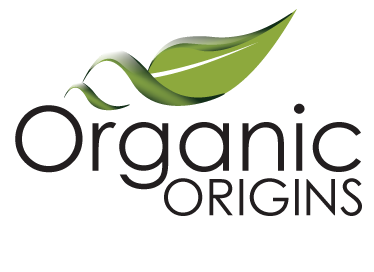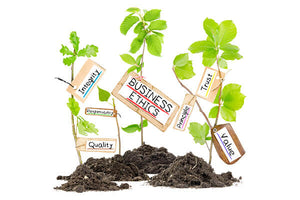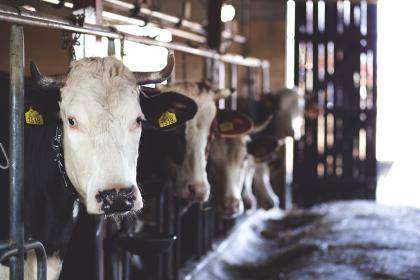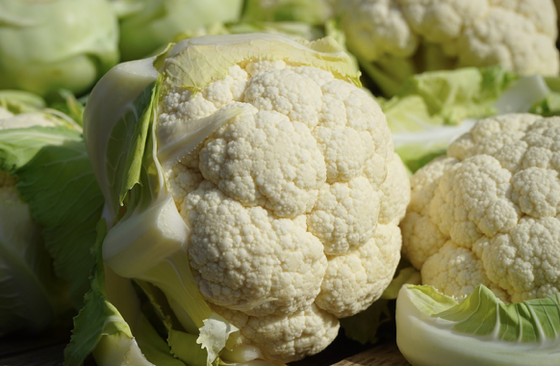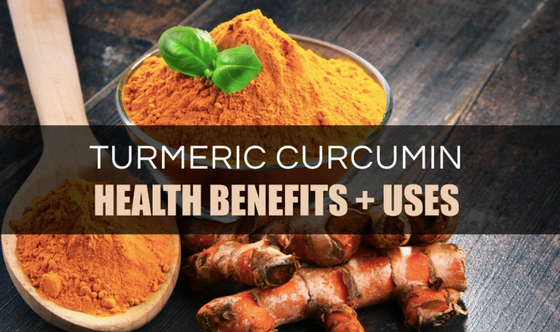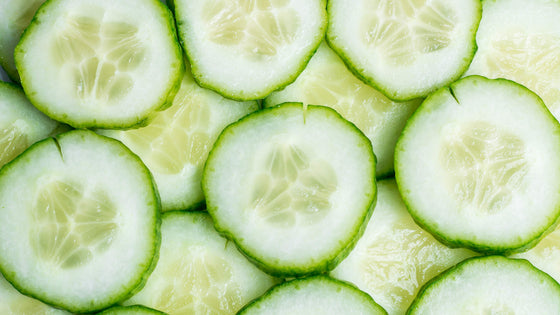We have never had more choice when it comes to what we eat; yet, with all this accessibility, the things we are eating are less healthy, more processed and have less flavour.
More often than not the food we eat has no connection to, or resemblance of, the place it has come from. The food found in our local supermarket aisles has often been picked early and traveled miles to reach us; In fact, it has recently been found that nearly 50% of our food and animal feed is imported.
Not only are the foods we are buying less fresh, but the pesticides used on crops can also be damaging to health and the local wildlife. Part of the decline of the bumblebee has been attributed to specific pesticides used on crops.
We need to look at the way our grandparents ate and start to value local and real produce. From understanding what organic, ethical and sustainable food means, to how we can be more ethical in our own kitchens, this resource aims to showcase the best way to approach eating ethically and sustainably, including advice, tips and recipes.
- What is Ethical and Sustainable Food
- Eat Locally Sourced Produce
- Seasonal Produce Guide
- Seasonal Recipes
- Ethically Eating Meat, Fish, and Dairy
- Growing your Own
- 10 Easy Swaps for Ethical and Sustainable Eating
What is Ethical and Sustainable Food?
The implications of what we choose to put on our plates, and what is brought to us on plates in restaurants, is far reaching. The choices you make will, ultimately, have an impact on the lives of others.
Understanding what ethical, sustainable and organic food means can help you to make decisions when you buy. Ethical factors surrounding food are those that are seen as being morally right. For example, buying food which is Fairtrade.
Sustainable food isn’t labelled as such, but Sustain, the alliance for better food and farming, work with the definition of ‘good food’ being food that is produced, processed, distributed and disposed of in ways that contribute to thriving local economies and sustainable livelihoods. It is also food that protects the diversity and welfare of both plants and animals, avoid contributing to climate change and wasting natural resources and provide social benefits.
Although it is hard to truly define specifically what ethical and sustainable food is, the main themes tend to overlap and, ultimately, if you have concerns about animal welfare, the impact on those involved in farming or the sustainability of using land and soil being more mindful over what ends up on your fork. You really can make a difference.
Although it can sometimes be hard to know exactly what food is ethical and sustainable, there are certain labels you can look out for when in your local shop or supermarket.
Organic Food
Organic standards are defined by law. If food is organic it means higher levels of animal welfare, lower level of pesticides and chemical fertilisers and the use of antibiotics are not permitted. Organic farmers must be certified by an approved organisation, such as The Soil Association. Keep an eye out for their logo on packaging.
The land where the organic food is produced is also managed in a more sustainable way, meaning that the area is better looked after and more wildlife is able to thrive!
Free Range
Chicken, Pork, Egg and Dairy products can be labelled Free Range. This means that the chicken and pigs are allowed access to the outdoors either part of, or all of the time. This means the animals have a more stimulating environment, where they are able to be active and exhibit more of their natural behaviors.
Pasture/Grass Fed
For cattle and sheep this label means that the animals are grazed outdoors on pasture as opposed to the alternative intensive practice of feeding and fattening the animals indoors or in CAFOs (concentrated animal feed operations). These animals are fed on grains, which is an unnatural, but cheap, diet for them.
Allowing the cattle and sheep to be pasture/grass fed is not only good for the animals themselves, but for the British landscape.
Beef that is pasture-reared has been found to contain less fat, have a healthier range of omega-3s as well as higher in calcium, magnesium, and potassium.
Outdoor Bred/Reared
This label refers mainly to pigs, which are born into systems that have outdoor space. 'Outdoor bred' pigs are born into space then brought indoors for fattening once they have been weaned. 'Outdoor reared' pigs are bred in the same way but also then spend half their lives outdoors.
Farm Assured/Red Tractor
Meat that is farm assured or has the red tractor label means that it is traceable back to a farm. Inspections on these farms are related to hygiene and food safety standards, rather than the animals welfare.
Why Eat Ethical and Sustainable Food?
There are many great reasons to eat organic, ethically and sustainably. The focus isn’t just on higher animal welfare but also food safety and quality. Eating ethically and sustainably means protecting the environment, ensuring nations have adequate food supply as well as looking to the future and making sure that food production can last not only for today but tomorrow as well.
Here are some great reasons you should start eating ethically and sustainably today:
- Produce is grown with fewer and less-toxic pesticides.
- Sustainable meat is raised with no antibiotics or hormones.
- Animals are more likely to live healthier and happier lives.
- GMOs (genetically modified organisms) are not used in organic and sustainable produce.
- Sustainable foods are typically healthier.
- Foods are grown in a more sustainable manner which is good for both the farmer and workers.
- Sustainable farming supports local economies.
- Less waste is produced in sustainable farming.
Just making some small changes to your daily food habits can make all the difference.
Eat Locally Sourced Produce
Buying sustainable food doesn’t have to be something that you make the change to overnight. Shopping locally also doesn’t necessarily mean attending your local farmer’s market every week (although that would be nice!). Making a start of ethical eating can be done by buying just one organic meat, dairy or
produce item in your next supermarket shop and building this up over time.
Buying food locally means that less food needs to be grown and transported to our shores. This is important as the latest data released around greenhouse gases linked to goods and services consumed by UK households, which includes emissions from the foreign manufacture of imported products, rose by 3% between 2012 and 2014. In order to see a change, we need to start thinking about the positive impact buying locally can have.
Not only can these changes benefit the environment but also your wallet. Seasonal, local produce can often be significantly cheaper than shipped and out of season fruits and vegetables.
You can find sustainable food in places such as:
- Farm Shops
- Restaurants
- Co-ops
- Farmer’s markets
- Organic Origins!
Ask Questions
At a farmer’s market you will have direct access to the source, so a great place to start asking questions so you can know exactly what you are eating and how it was produced. It is also a great way of getting involved in your community and getting a conversation going.
Sustainabletable.org offer the below questions to ask if you are at a market or talking to a farmer:
- How are your animals raised?
- Are your animals ever given antibiotics? Or hormones?
- What time of fertilisers to you use?
- How many different types of produce do you grow?
- How many types of breeds to you grow?
A more extensive list is available to view at here.
Clean Fifteen
The Environmental Working group have released a list called the ‘clean fifteen’ naming the least pesticide-ridden fruit and vegetables. If you are not able to buy organic, these are the best choice when it comes to fruit and veg that have found have the least pesticides on them:
- avocados
- sweetcorn
- pineapples
- cabbage
- frozen peas
- onions
- asparagus
- mangoes
- papayas
- kiwis
- eggplant
- grapefruit
- cantaloupe
- cauliflower
- sweet potatoes
They have also offered up a list of the fruit and veg found to have the most pesticides on them known as 'The Dirty Dozen':
- apples
- strawberries
- grapes
- celery
- peaches
- spinach
- sweet bell peppers
- imported nectarines
- cucumbers
- cherry tomatoes
- imported snap peas
- potatoes
Seasonal Produce Guide
Chefs such as Nigel Slater and Hugh Fearnley-Whittingstall are avid advocates of seasonal eating - and for good reason too. Buying seasonal produce means:
- A reduction in energy needed to grow and transport unseasonal food.
- Saving money - you don’t need to pay a premium for food that is scarcer or has travelled a long way.
- Supporting local and British economy
- Seasonal produce will be fresh and therefore will tend to have a lot more flavour. Plus, be full of more nutrients!
|
Season |
Best for |
Also in season |
|---|---|---|
|
January |
Clams, Kale and Carrots |
Cauliflower, Leeks, Brussels Sprouts, Savoy Cabbage, Clams, Seville Oranges, Blood Orange, Cockles, Horseradish, Mussels, Artichokes, Parsnips, Swede, Truffle, Venison, Clementine, Jerusalem Artichoke, Salsify, Satsuma, Wild Duck and Winkles. |
|
February |
Leeks and Savoy Cabbage |
Cauliflower, Carrots, Brussels Sprouts, Kale, Clams, Blood Oranges, Cockles, Oysters, Venison, Winkles and Spring Greens. |
|
March |
Sardines and Spring Greens |
Spring Onions, Clams, Leek, Kale, Savoy Cabbage, Venison, Purple Sprouting and Cauliflower. |
|
April |
Lamb and Cauliflower |
Crab, Rocket, Watercress, Wild Garlic, Oyster, Sardines, Spring Onions, Spring Greens, Cucumber and Kale. |
|
May |
Rhubarb and Asparagus |
Spinach, Chicory, Gooseberries, New Potatoes, Radish, Samphire, Crab, Morels, Cauliflower, Elderflower, Nectarine and Cucumber. |
|
June |
Peas, Broad Beans and Strawberries |
French Beans, Chicory, Crab, Mackrel, Mangetout, Rhubarb, Courgette, Asparagus, Spinach, Carrots, Radish, Rocket, Spring Onions, Tomato, Watercress, Lamb and Cucumber. |
|
July |
Cucumbers, Lettuce and Cherries |
Apricot, Aubergine, Blackcurrant, Beetroot, Celery, Bramley Apples, Spinach, Rhubarb, Raspberries, Runner Beans, Carrots, Peas, Iceberg Lettuce, Fennel, Courgettes, Globe Artichoke, Kohlrabi, Peach, Strawberries, Blueberries, Cauliflower, Savoy Cabbage, Runner Beans, Sea Bass, Swiss Chard and Cos Lettuce. |
|
August |
Cos Lettuce, Raspberries and Plums |
Blueberries, Celery, Cauliflower, Marrow, Strawberries, Sweetcorn, Spinach, Bramley Apples, Cucumber, Red Cabbage, Runner Beans, Broad Beans, Savoy cabbage, Spring Greens, Iceberg Lettuce, Carrots, Peas, Cherries and Courgettes. |
|
September |
Courgette, Blackberries and Runner beans |
Red Cabbage, Damsons, Figs, White Cabbage, Marrow, Partridge, Pear, Blueberries, Iceberg Lettuce, Squash, Sweetcorn, Grouse, Lamb, Mackerel, Scallop, Rocket, Sea Bass, Swiss Chard, Wild Duck, Venison, Savoy Cabbage, Kale, Bramley Apples, Spinach, Cos Lettuce, Leeks, Plums, Pumpkin, Peas, Cucumber, Cauliflower, Celery, Carrots and Brussels Sprouts. |
|
October |
Sweetcorn and Apples |
White Cabbage, Celeriac, Mussels, Pheasant, Salsify, Wild Mushroom, Aubergine, Squash, Red Cabbage, Kale, Savoy Lettuce, Spring Greens, Marrow, Carrots, Blackberries, Leeks, Celery, Runner Beans, Brussels Sprouts, Pheasant, Pumpkin, Winkles, Wild Mushrooms, Fennel, Globe Artichoke, Grey Mullet, Oysters, Lamb, Damsons, Swede, Pear, Sloe Berries and Potatoes. |
|
November |
Potatoes and Red Cabbage |
White Cabbage, Brussels Sprouts, Chestnuts, Clams, Cranberries, Horseradish, Jerusalem Artichoke, Parsnips, Spring Greens, Kale, Savoy, Quince, Apples Cabbage, Leeks, Cauliflower, Carrots, Oysters, Partridge, Pheasant, Sea Bass, Venison, Mussels, Wild Duck and Brussels Sprouts. |
|
December |
Turkey, Brussels Sprouts and White Cabbage |
Apple, Kale, Celeriac, Spring Greens, Clams, Horseradish, Jerusalem Artichoke, Oyster, Parsnips, Goose, Pheasant, Salsify, Swede, Oysters, Mussels, Savoy Cabbage, Potatoes, Carrots and Cauliflower. |
Seasonal Recipes
We have hunted out some fantastic recipes that make the very best of the seasonal produce available here in the UK.
January
After the party season has finished, this is the perfect time to fill up on warming and healthy meals made with the great winter veg that is available, such as kale and carrots. Warming vegetable soups, tasty one-pots, and bright-tasting oranges are perfect to eat throughout January.
February
Now is the time for green. Savoy cabbage and leeks are the prime veg of the month, reap the health benefits with the filling and delicious recipes.
March
This is the month for spring greens, a delicious vegetable that works as a fantastic side not only is this vegetable cheap but you get a lot for your money!
April
Spring has sprung and with it comes a crop of new spring vegetables. Cauliflower is the star this month, spiced and roasted it is delicious in a salad, as the main part of a veggie curry or simply as a healthy side. When it comes to meat, this is the season of lamb just remember to go for British born and reared.
Also, if you are out walking in the countryside keep an eye out for wild garlic which grows in abundance at this time of year.
- Spiced cauliflower with toasted coconut and red lentils
- Cauliflower and chickpea curry recipe
- Hot harissa lamb with couscous
- Wild garlic salsa verde
May
This month the stars have to be Rhubarb - delicious both in deserts, but also as a delicious simple compote to put on breakfast and yoghurt. Asparagus, usually quite an expensive vegetable should be a little cheaper this month due to its seasonality, it works wonderfully with egg.
- Gooseberry and rhubarb with clotted cream
- Roast leg of pork with spiced rhubarb
-
Linguine with asparagus and egg
June
The start of summer means lovely broad beans and sweet tasting peas to add to your plate. British strawberries are also prime for the picking, delicious when scattered over cereal or just eaten on their own!
July
Lighter meals are now on the menu. Lettuce, this month's star is delicious used as a wrap or for as part of a crisp and tasty salad. Cherries are the stand-out fruit of the season, sweet and juicy they world so well with almonds and the cherry and almond pudding below is to die for.
August
Cos lettuce is crisp and delicious and works so well with lemons, like in the below salad. Raspberries should be sweet and plump during August, have fresh or preserve for a tasty jam. Plums are also prime this month, a great snack or beautiful in the plum and almond tart below.
September
If you are home-growing courgettes (definitely worth a try if you haven't as they are easy to grow even for the non-green fingered of you) September will probably provide you with an abundance of courgettes. Not only delicious as a savoury side, the below recipe for a courgette and poppy seed cake is excellent as a slightly different treat.
Blackberries are also out in full force in September, have fresh in yoghurt or why not pop a few into some cheap whisky to store as a boozy treat.
- Pan fried sea bass with courgette ribbons and mussel soup
- Runner beans with bacon and hazelnuts
- Blackberry whisky
- Courgette and Poppy-seed cake
October
Autumn is now in full swing, sweetcorn and pumpkin steal the show this month. Try these delicious sweetcorn fritters which are complemented by sweet, slow-cooked tomatoes. Also, carving out your pumpkin for Halloween? Waste not, want not - use the tasty pumpkin flesh to have this warming pumpkin and chickpea tagine.
Pears are the star fruit of October - add into a crumble with apples and blackberries for a tasty desert just top off with a glug of custard.
- Sweetcorn fritters with slow-cooked tomatoes
- Pumpkin and chickpea tagine
- Apple, pear and blackberry crumble
November
Although potatoes, for most of us, are a staple all year round November is the month to load your plate with them. As the dark nights draw in what could be better than some lovely roasted potatoes covered in gravy or the below tasty herby root vegetable gratin full with creamy potato, swede, and parsnip.
Also, make a big batch of the red cabbage sauerkraut and eat with everything!
December
December is the month of indulgence. It is also the month for plenty of warming veg. Why not throw some of the season's root vegetables - such as carrot and swede - into a slow cooker for a wonderful stew?
Christmas wouldn't be Christmas without Turkey, but don't just save it for Christmas Day. Why not give this delicious turkey, brie and cranberry wellington a go?
View a printable version of the seasonal eating guide here.
Our Favourite Seasonal Cookbooks
Nigel Slater - The Kitchen Diaries
Hugh Fearnley-Whittingstall - The River Cottage Year
The Abel and Cole Cookbook - Easy, Seasonal, Organic
Ethically Eating Meat, Fish, and Dairy
Large-scale meat production, that is produced on a small time scale, only benefits those that take profits from the meat sales. A great way of sustainably and ethically eating meat is to reduce the frequency in which you eat meat, replacing some meat with the vast variety of fish that is available.
If you do choose to eat meat, eating sustainably-raised animals means good things for the lives of animals. Factory-farmed animals are subjected to unsanitary conditions, crammed into spaces where they cannot move, with little to no sunlight and end up getting sick. This then means pumping the animals with antibiotics. 70 million farm animals are not being produced for food and of those 70 million, two-thirds are factory farmed according to Compassion in World Farming.
Hugh Fearnley-Whittingstall is an avid campaigner of eating less, but better meat:
“I’ve always said we should be eating less meat, of higher quality, and the highest possible welfare standards ... It’s right for our health, right for the planet and only fair to the millions of farm animals we raise for food”
Buying Meat
Animals that are raised sustainably get to live happy and free lives where they are able to roam outside, for at least part of the day. When buying meat, eggs or dairy that is produced in this way it will be labelled Free Range.
Buying Chicken and Poultry
Over 70% of chicken meat is produced in industrial systems. The majority of Chickens and Turkeys bred for meat grow so fast that their bones, heart, and lungs can’t support their weight, causing crippling lameness and often heart failure.
Big chicken farms often cage around 50,000 birds in one house. They do not get to go outside or see daylight. Free range birds, on the other hand, are able to access the outdoors and given much more space to roam. You are also able to purchase birds that are kept indoors but have a higher quality of life with more space, daylight, and a better environment.
Buying Beef and Lamb
Here in the UK, nearly all beef cattle and lambs are reared outdoors. This is not guaranteed though, so make sure to check the label for ‘Organic’, ‘Grass-fed’ and ‘Access to pasture’.
Buying Pork and Bacon
When buying pork or bacon keep an eye out for organic or free-range products. In the UK organic production offers higher animal welfare with organic pigs being reared outdoors with access to straw bedded huts and large paddocks.
Organic outside of the UK doesn’t necessarily offer these welfare practices, organic pigs may only have access to an outdoor run in other countries in Europe.
If you do have to buy pig meat products from pigs that are reared indoors, make sure to look for ‘deep bedded’ or ‘straw bedded’.
Buying Veal
After campaigns in the 80s and 90s, the vilified use of veal crates - which were so small that calves weren’t able to turn around - were banned in 2007 across the EU.
Buying veal these days, however, is important for the dairy industry as this means more dairy cows aren’t shot at birth or exported the long journey to continental veal farms.
British law means veal calves have bedding, more space as they grow and better welfare in terms of diet.
Buying Fish
Over 80% of the world fish stocks being fully or over-exploited from fishing, the future of our fish stocks are in serious danger.
Take a look online at www.goodfishguide.org where you can see the latest list of sustainable fish, as well as pick up some tips on what fish to avoid and recipes for fish from big name chefs!
You can also download their app today here.
Buying Eggs
The best choice when buying eggs is to go for Free Range.
‘Free range’ hens are able to access the outdoors and are free to roam inside also. ‘Barn hens’ are allowed to roam within a barn, but they do not have access to the outdoors. The cheapest eggs available are usually from cage systems which offer little to no space for the hens to move and carry out natural behaviors. These hens will remain inside so do not get to see natural light.
Remember when purchasing egg-containing products such as mayonnaise, cakes, biscuits etc. these products most likely will contact caged hen eggs unless the ingredients say ‘free-range eggs’ or ‘barn eggs’.
Buying Dairy
Organic dairy farming ensures cows are able to graze on pastures during grass growing
season, as well as encouraging better welfare and breeding of the animals.
Other dairy cows, specifically the Holstein-Friesian cow, have been selectively bred to produce a higher milk yield. This type of cow is susceptible to diseases such as lameness, mastitis as well as fertility problems. These cows require a strict management so are often kept indoors permanently. Cows can live for around 20 years, but in commercial systems are often slaughtered at 5 or 6 years, sometimes a lot less.
Growing your Own
From the smallest of windowsills to a few acres of land, growing fruit or vegetables is probably a lot easier than you’d expect. Not only can it be extremely rewarding, but economical and reduces your carbon footprint by only needing to travel from your garden to your plate.
Fresh salads, juicy fruits and homegrown vegetables can all be yours; it will just take a little TLC to have your very own produce at home. You really can see something grow from seed to being part of your dinner.
The internet has a wealth of free knowledge for you to use sites such as the BBC, and RHS have great tips to get you going and more in-depth details on how to grow specific types of vegetables but take a look below to get started with growing. Also take a look over at www.verticalveg.org.uk; a fantastic website for smaller spaces which can help to get you growing.
Getting Started
- Big or small space, it is best to start small with your initial crop.
- Choose vegetables that you and your family will enjoy - no point growing a load of courgettes if no one is going to eat them!
- Choose vegetables such as lettuce and beans that will keep producing more over a long harvest period - will save you a lot in the long run. The more you pick beans the more they produce!
- Once you know what you want to plant, you can determine how much space you will need. If your garden is small you can plant in containers and pots, or even grow bags.
Best Vegetables for Beginners
Salad - Lettuce can be grown easily on a windowsill if your space is limited.
To get going with lettuce, sow your seeds indoors then thin these out when you plant them outside. Lettuce plants are able to work whether close together - which gives a
Courgettes - Growing courgettes can be extremely satisfying as they can
Not only can you eat the tasty vegetable, but the flowers are also delicious - try frying them in a light batter when stuffed with ricotta and goats cheese.
Tomatoes - Tomatoes are a brilliant vegetable to grow as they are relatively easy and nearly always give you a lot of veg in return. Raise from seed in March on a well-lit windowsill.
Once the danger of frost has passed, plant them out in late May or early June. For the best flavour, give them as much sun as possible!
Beans - Beans are super easy to grow. This is great news when a lot of supermarket shelves are full of imported beans that can be quite expensive.
Runner beans will be an easy variety to grow and should crop for months if you pick them every few days. Broad beans are also really easy to grow and produce beans during late autumn and early summer.
Potatoes - Suitable for both big and small gardens, potatoes are perfect for planting in the ground or into containers.
New potatoes, also known as early potatoes, are ready to harvest much sooner than maincrops. Plant in April and by late June or July you’ll have lots of new potatoes to eat.
Planting Tips
- Vegetable plants will grow best in sheltered and sunny spots.
- If shady, these vegetables are still able to grow - beetroot, carrots, kale, lettuce, potatoes, radishes, rhubarb, spring onions spinach and swiss chard.
- Plant in sight. This way you will remember to tend to them!
Allotments
in 2011 there were at least 87,000 people across the country on allotment waiting lists. If you get the green-fingered bug take a look over at www.gov.uk/apply-allotment to apply.
Tips for Sustainable Growing
- Make your own compost - try a wormery if you have a smalls space
- Waste not, want not. Big yields such as courgettes can leave you with a few. Sharing with your friends, family and neighbours is great or why not try preserving or pickling your fruit or veg?
10 Easy Swaps for Ethical and Sustainable Eating
-
Swap your normal cow’s milk to organic cow’s milk or dairy free alternatives, such as Nut or Soy Milk.
-
Buy free range eggs, or - even better - organic!
-
Eat less, but better, meat such as organic, grass-fed or reared outdoors.
-
Sign up for an organic veg box, or why not try out your local farmer’s market?
-
Visit your local fishmonger or butcher to pick up some meat or fish.
-
Swap out of season veg for something seasonal - it will most likely be cheaper too!
-
Instead of a processed meal, make a large amount of a homemade meal and freeze for a quick meal that is healthier.
-
Don’t empty your cupboards straight away, throwing away everything is a waste. Slowly upgrade as you go to make-over your kitchen.
-
Surplus vegetables or fruit? Learn to preserve food - especially homegrown - these will taste way better and be full of fewer additives than store bought!
-
Opt for a Fairtrade certified product - this ensures that producers receive a fair deal.
